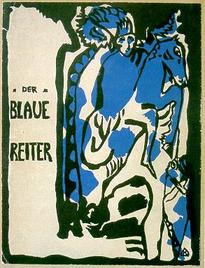
Der Blaue Reiter is a designation by Wassily Kandinsky and Franz Marc for their exhibition and publication activities, in which both artists acted as sole editors in the almanac of the same name, first published in mid-May 1912. The editorial team organized two exhibitions in Munich in 1911 and 1912 to demonstrate their art-theoretical ideas based on the works of art exhibited. Traveling exhibitions in German and other European cities followed. The Blue Rider disbanded at the start of World War I in 1914.

August Robert Ludwig Macke was a German Expressionist painter. He was one of the leading members of the German Expressionist group Der Blaue Reiter. He lived during a particularly active time for German art: he saw the development of the main German Expressionist movements as well as the arrival of the successive avant-garde movements which were forming in the rest of Europe. As an artist of his time, Macke knew how to integrate into his painting the elements of the avant-garde which most interested him. Like his friend Franz Marc and Otto Soltau, he was one of the young German artists who died in the First World War.
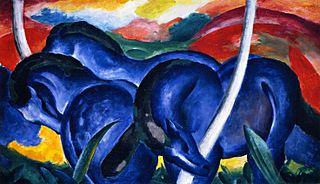
Blue Horses or Die grossen blauen Pferde is a 1911 painting by German painter and printmaker Franz Marc (1880–1916).
Formula composition is a serially derived technique encountered principally in the music of Karlheinz Stockhausen, involving the projection, expansion, and Ausmultiplikation of either a single melody-formula, or a two- or three-voice contrapuntal construction.

Ausmultiplikation is a German term used by the composer Karlheinz Stockhausen to describe a technique in which a long note is replaced by shorter "melodic configurations, internally animated around central tones", resembling the ornamental technique of divisions in Renaissance music. Stockhausen first described this technique in connection with his "opus 1", Kontra-Punkte, composed in 1952–53, but in his later formula composition there is a related method of substituting a complete or partial formula for a single very long tone in a much slower, "more background" projection of the formula. When this is done at more than one level, the result is reminiscent of a fractal.
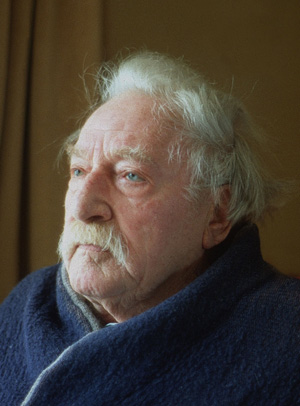
Egon Arnold Alexis Freiherr von Vietinghoff genannt Scheel was a German-Swiss painter, author, philosopher and creator of the Egon von Vietinghoff Foundation. He reconstructed the lost painting techniques of the Old Masters, and created some 2,700 paintings.

The Master of the Saint Bartholomew Altarpiece was an Early Netherlandish painter active in Germany, mostly Cologne, between 1475/1480 and 1510. Despite his anonymity, he is one of the most recognizable artists of the early Renaissance period in German art.

Harlekin (Harlequin) is a composition for unaccompanied clarinet by Karlheinz Stockhausen, named for the commedia dell'arte character Harlequin. It was composed in 1975 and is Number 42 in his catalogue of works. A shorter, derived work called Der kleine Harlekin is Number 42½.

Stop is a composition for orchestra by Karlheinz Stockhausen, work-number 18 in the composer’s catalogue of works, where two performing realisations are also found as Nr. 18½ and Nr. 18⅔.
Unsichtbare Chöre is an eight-channel electronic-music composition by Karlheinz Stockhausen. A component part of the opera Donnerstag aus Licht, it may also be performed as an independent composition, in which form it is designated "ex 49" in the composer's catalog of works.

Bazon Brock is a German art theorist and critic, multi-media generalist and artist. He is considered a member of Fluxus. He was a professor of aesthetics at the Hochschule für bildende Künste Hamburg, the University of Applied Arts Vienna and the University of Wuppertal.
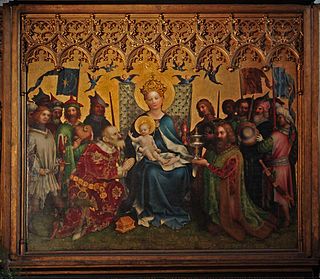
The term Cologne School of Painting was first applied in the 19th century to describe old German paintings generally. It subsequently came to refer more specifically to painters who had their workshops in medieval Cologne and the lower-Rhine region from about 1300 to 1550.

Franz Theobald Horny was a German painter in the Romantic style.

The Donkey Rider is a watercolor created in 1914 by the German Expressionist painter August Macke. It was created during the art-historically significant trip to Tunisia that he took with fellow painters Paul Klee and Louis Moilliet in April 1914. The watercolor is now in the collection of the August-Macke-Haus in Bonn.
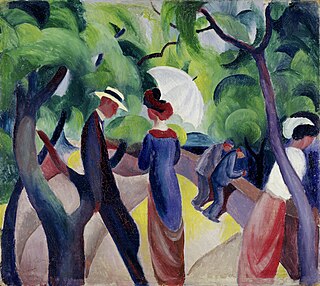
Promenade is an oil-on-cardboard painting by the German artist August Macke, executed in 1913. It is held at the Städtische Galerie im Lenbachhaus in Munich. Chronologically, it is the first of the paintings that he created after moving to Hilterfingen in Switzerland.

Woman with Umbrella in Front of a Hat Shop is an oil-on-canvas painting executed in 1914 by the German painter August Macke. It depicts a woman peeking into a hat shop, painted in an Expressionist style. The painting is in the collection of the Museum Folkwang in Essen.

Lady in Green Jacket is an oil-on-canvas painting by German artist August Macke, executed in 1913. It is held in the Museum Ludwig in Cologne.

Girls in Green, also known as Girls under Trees, is an oil-on-canvas painting by the German painter August Macke, executed in 1914. It depicts a number of girls among the trees on the edge of a lake, where the color areas of the figures and the environment seem to merge. The painting is in the collection of the Pinakothek der Moderne in Munich.

Fox, also known as Blue and Black Fox or Blue Fox, is an oil on canvas painting by Franz Marc, from 1911. It is part of the collection of the Von der Heydt Museum in Wuppertal.

Large Bright Showcase is an oil-on-canvas painting by the German artist August Macke, executed in 1912. It is held at the Sprengel Museum in Hanover.


















